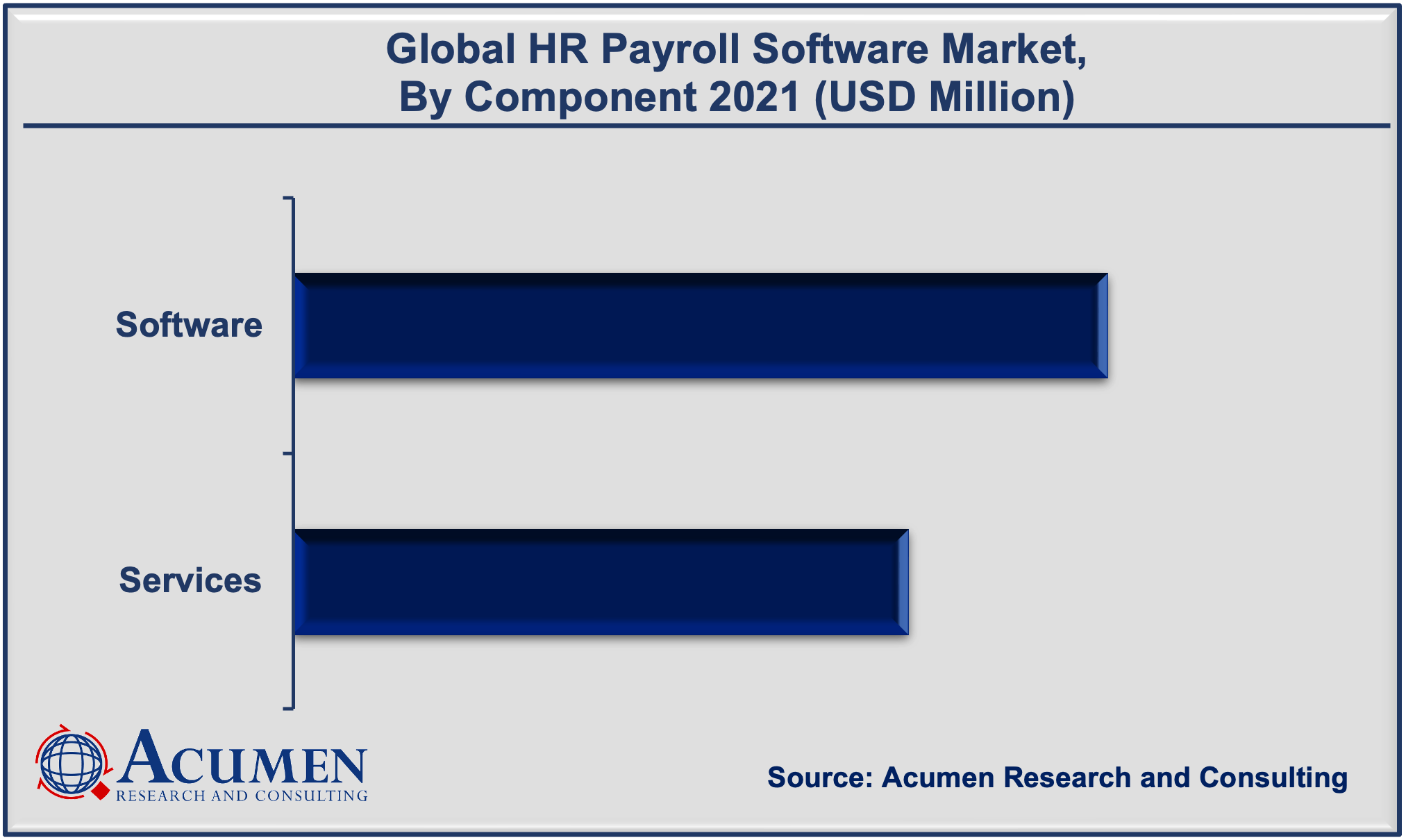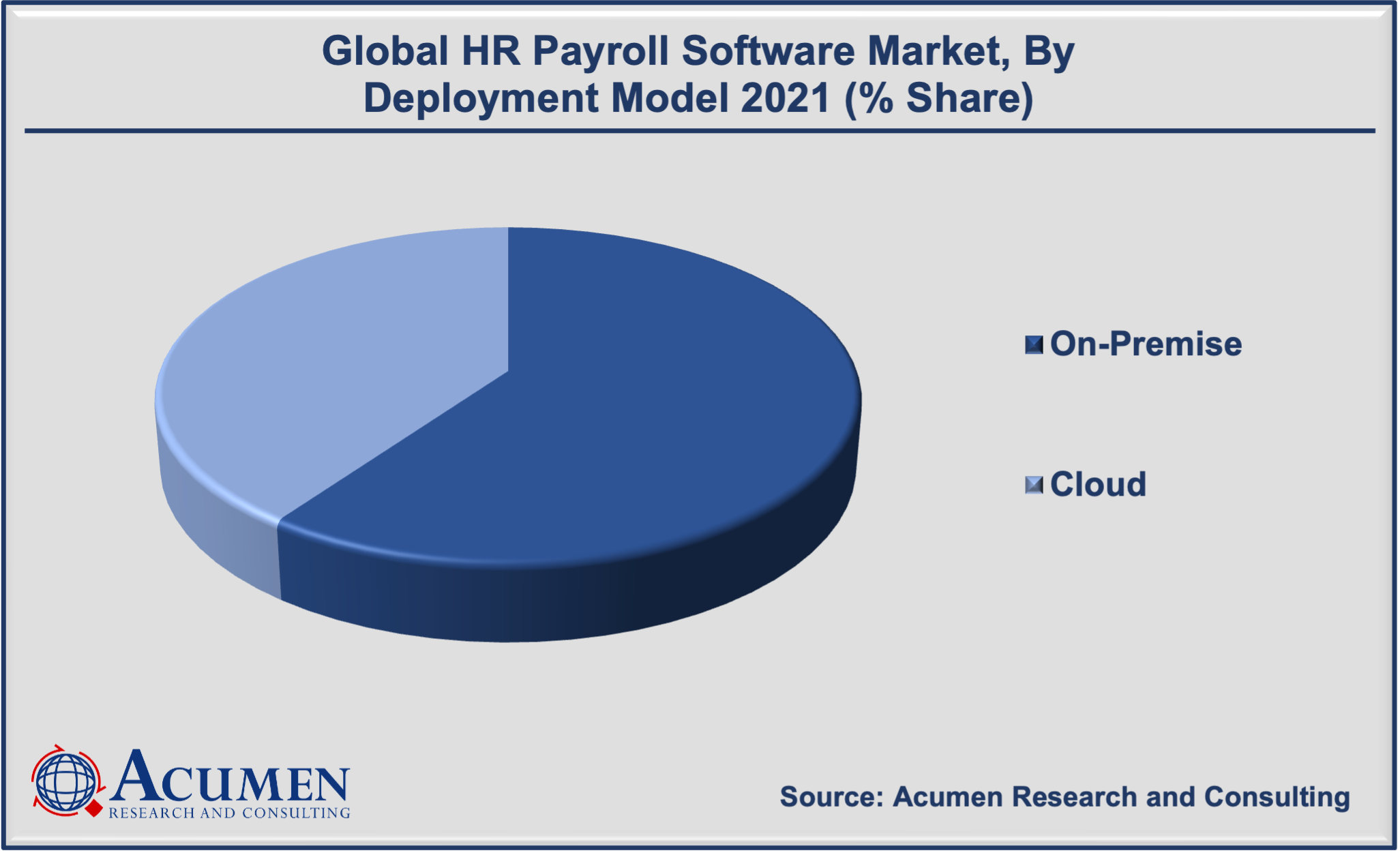HR Payroll Software Market Analysis - Global Industry Size, Share, Trends and Forecast 2022 - 2030
Published :
Report ID:
Pages :
Format :
The Global HR Payroll Software Market Size accounted for USD 23,489 Million in 2021 and is projected to reach USD 52,867 Million by 2030, with a CAGR of 9.5% from 2022 to 2030.

According to our HR payroll software industry analysis, the rising automation in HR processes is going to expand the market growth in the coming years. The increasing number of corporate offices, banks, and institutions in emerging nations are considered one of the prominent HR payroll software market trends that will boost the industry demand. An HR payroll software is valuable to any type of business. Payroll processing, maintaining salary details for every person in the workplace, keeping track of deductions, time and attendance management, loans, bonuses, and allowances are all tasks performed by the human resources department. Payroll software that is robust, integrated, and fully optimized can assist organizations of all sizes in maintaining compliance with laws and other financial regulations while also reducing costs. This liberates human resources (HR) teams from routine tasks, allowing them to devote more time to strategic budgeting, planning, and other business-forward initiatives.
HR Payroll Software Market Growth Drivers:
- Growing need for a cost-effective HR payroll system
- Increasing digitalization and automation in payroll systems
- Comprehensive and flexible solutions offered by these systems
HR Payroll Software Market Restraints:
- Rising data security and privacy concerns
- Lack of payroll professionals
HR Payroll Software Market Opportunities:
- Surging demand from cloud-based technologies
- Advent of artificial intelligence in these systems
Report Coverage
| Market | HR Payroll Software Market |
| Market Size 2021 | USD 23,489 Million |
| Market Forecast 2030 | USD 52,867 Million |
| CAGR During 2022 - 2030 | 9.5% |
| Analysis Period | 2018 - 2030 |
| Base Year | 2021 |
| Forecast Data | 2022 - 2030 |
| Segments Covered | By Component, By Deployment Model, By Organization Size, By Industry Vertical, And By Geography |
| Regional Scope | North America, Europe, Asia Pacific, Latin America, and Middle East & Africa |
| Key Companies Profiled | SAP SE, Ascentis Corporation, ADP, LLC, Cornerstone OnDemand, Inc., Paycom software inc, Oracle Corporation, Patriot software, Sage Plc., Epicore Software, and SumTotal Systems Inc. |
| Report Coverage |
Market Trends, Drivers, Restraints, Competitive Analysis, Player Profiling, Regulation Analysis |
| Customization Scope |
10 hrs of free customization and expert consultation |
The surging levels of automation in the HR payroll system are the primary factor boosting the HR payroll software market revenue. Real-time insights from automated payroll software can be easily translated into graphs and charts that managers can use to make key business decisions. The best payroll systems offer a straightforward, consistent user experience across platforms. When an employee views the dashboard on their phone, it looks exactly like it does on their desktop, with insightful interactions that minimize the need for help desk calls. Another significant advantage of cloud-based payroll systems is automation, which often includes artificial intelligence (AI) to forecast needs and reduce errors. Onboarding new employees, for example, can be automated so that every new employee for a given position is properly onboarded, following the same guidelines and processes and making sure that nothing is missed.
Comprehensive and flexible solutions offered by these systems are expected to surge the demand among a group of several industry verticals. When a company's needs change, payroll software makes it simple to adapt. For example, when a new office opens in a new region with new taxes and regulations, the software automatically incorporates the new rules, eliminating the need to enter data for each employee. This way HR payroll software simplifies time-consuming processes and saves workforce productivity.
However, rising numbers of data thefts, as well as a risk to privacy, are some of the aspects that are limiting the market growth. To overcome these issues, companies are introducing safe and reliable software that enables organizations to define user roles and provide role-based access to the staff handling payroll system for enhanced data security.
Furthermore, the growing demand for cloud-based payroll software is expected to generate numerous growth opportunities for the market in the coming years. One of the primary advantages of cloud-based payroll management is that data can be accessed from any location using a desktop computer or smartphone.
HR Payroll Software Market Segmentation
The global HR payroll software market is segmented based on component, deployment model, organization size, industry vertical, and region.
HR Payroll Software Market By Component
- Software
- Services

Based on our analysis, the software segment dominated the maximum market share in 2021 and is likely to do so during the forecast timeframe from 2022 to 2030. The high growth in the segment is credited to the elevated demand for payroll software among organizations for streamlining the manual process and promoting employee trust. However, the services sector is expected to grow the most in the coming years. HR payroll services improve software implementation, increase the value of existing installations by optimizing them, and reduce deployment costs and risks. As a result, the segment is experiencing rapid growth.
HR Payroll Software Market By Deployment Model
- On-Premise
- Cloud

The on-premise segment is expected to have a significant market share in 2021. This is due to the numerous benefits provided by on-premise deployments, such as a high level of data safety and security. Meanwhile, the cloud-based HR payroll software market is expected to grow at the fastest rate between 2022 and 2030. Cloud-based payroll systems typically include pre-configured options, but they also make it simple to configure and customize workflows and checklists as business requirements change. Cloud-based systems, on the other hand, scale easily, maintaining simplicity regardless of the number of deadlines, approvals, task owners, and dependencies involved in a given payroll process.
HR Payroll Software Market By Organization Size
- Large Enterprises
- SMEs
Among them, the large enterprises segment requires HR payroll solutions to streamline all the human resource processes for hundreds and thousands of employees. However, SMEs are expected to attain the fastest CAGR in the coming future. This is owing to the growing number of start-ups in emerging countries such as China and India. Furthermore, the surging awareness regarding the HR payroll software in these countries has created a buzz in existing and new small and medium businesses, thereby supporting the market share.
HR Payroll Software Market By Industry Vertical
- IT& Telecom
- Retail
- BFSI
- Healthcare
- Manufacturing
- Transportation and Logistics
- Others
Healthcare is one of the most widespread and important industries in the world. HR software for healthcare manages all employee salaries, and taxes, and ensures that worker deductions such as advantages, retirement savings, and taxes are debited before the salary is credited. Additionally, HR software for healthcare also offers an employee all of the information they require, such as their income slip and pay scale. Many hospital payroll software packages include an employee-facing portal where employees can access all necessary information.
HR Payroll Software Market Regional Overview
North America
- U.S.
- Canada
Europe
- U.K.
- Germany
- France
- Spain
- Rest of Europe
Latin America
- Mexico
- Brazil
- Rest of Latin America
Asia-Pacific
- India
- Japan
- China
- Australia
- South Korea
- Rest of Asia-Pacific
The Middle East & Africa (MEA)
- Gulf Cooperation Council (GCC)
- South Africa
- Rest of the Middle East & Africa
Presence Of Giant Businesses And Advanced Software Companies In North America Fuel The Regional Market Growth
According to the HR payroll software market regional outlook, North America has the largest market share worldwide. The presence of well-established businesses such as healthcare, BFSI, retail, and so on has contributed to North America's largest market share. All of these companies employ hundreds of thousands of people, so in order to manage the payroll of such a large workforce, companies are turning to payroll solutions rather than manual human resources. Meanwhile, the Asia-Pacific region is expected to experience significant market growth as a result of the increasing number of SMEs and the rising youth labor force that is joining companies.
HR Payroll Software Market Players
Some of the top vendors offered in the professional report include SAP SE, Ascentis Corporation, ADP, LLC, Cornerstone OnDemand, Inc., Paycom software inc, Oracle Corporation, Patriot software, Sage Plc., Epicore Software, and SumTotal Systems Inc.
Frequently Asked Questions
How big was the market size of global HR payroll software market in 2021?
The global HR payroll software market accounted for USD 23,489 Million in 2021.
What will be the projected CAGR for global HR payroll software market during forecast period of 2022 to 2030?
The projected CAGR HR payroll software market during the analysis period of 2022 to 2030 is 9.5%.
Which are the prominent competitors operating in the market?
The prominent players of the global HR payroll software market involve SAP SE, Ascentis Corporation, ADP, LLC, Cornerstone OnDemand, Inc., Paycom software inc, Oracle Corporation, Patriot software, Sage Plc., Epicore Software, and SumTotal Systems Inc.
Which region held the dominating position in the global HR payroll software market?
North America held the dominating share HR payroll software during the analysis period of 2022 to 2030.
Which region exhibited the fastest growing CAGR for the forecast period of 2022 to 2030?
Asia-Pacific region exhibited fastest growing CAGR for HR payroll software during the analysis period of 2022 to 2030.
What are the current trends and dynamics in the global HR payroll software market?
Growing need for cost-effective HR payroll system, increasing digitalization and automation in payroll systems, and comprehensive and flexible solutions offered by these systems drives the growth of global HR payroll software market.
By segment component, which sub-segment held the maximum share?
Based on component, software segment held the maximum share for HR payroll software market in 2021.


